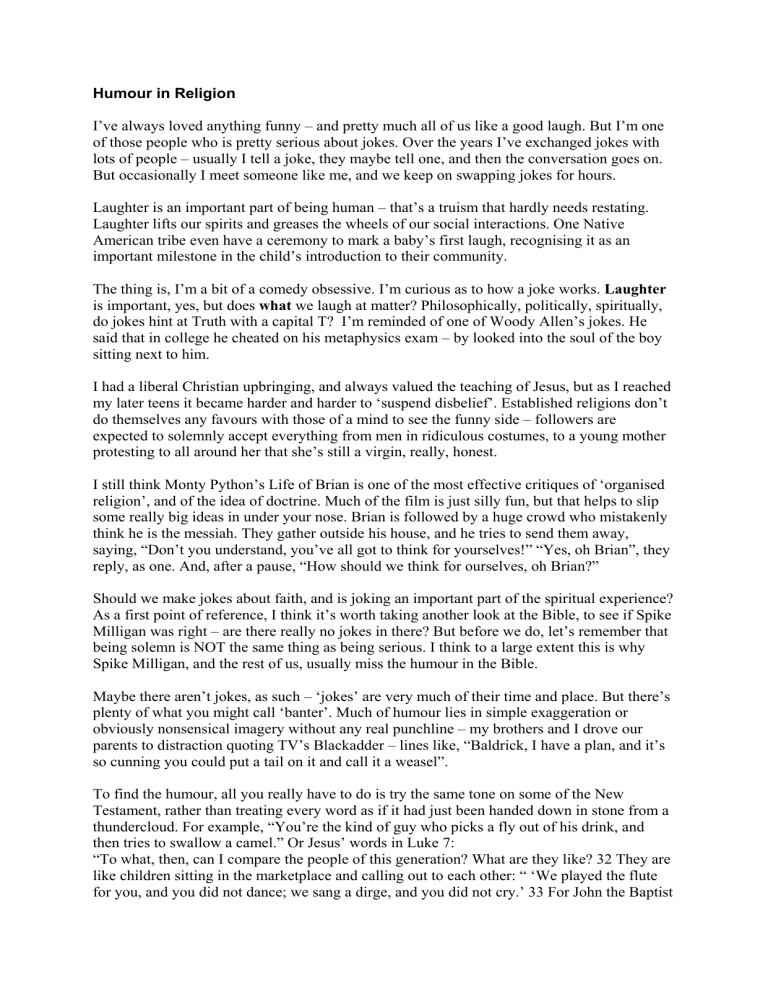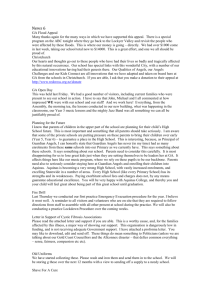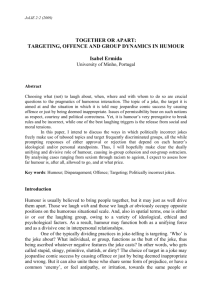Humour in Religion - UKunitarians.org.uk

Humour in Religion
I’ve always loved anything funny – and pretty much all of us like a good laugh. But I’m one of those people who is pretty serious about jokes. Over the years I’ve exchanged jokes with lots of people – usually I tell a joke, they maybe tell one, and then the conversation goes on.
But occasionally I meet someone like me, and we keep on swapping jokes for hours.
Laughter is an important part of being human – that’s a truism that hardly needs restating.
Laughter lifts our spirits and greases the wheels of our social interactions. One Native
American tribe even have a ceremony to mark a baby’s first laugh, recognising it as an important milestone in the child’s introduction to their community.
The thing is, I’m a bit of a comedy obsessive. I’m curious as to how a joke works.
Laughter is important, yes, but does what we laugh at matter? Philosophically, politically, spiritually, do jokes hint at Truth with a capital T? I’m reminded of one of Woody Allen’s jokes. He said that in college he cheated on his metaphysics exam – by looked into the soul of the boy sitting next to him.
I had a liberal Christian upbringing, and always valued the teaching of Jesus, but as I reached my later teens it became harder and harder to ‘suspend disbelief’. Established religions don’t do themselves any favours with those of a mind to see the funny side – followers are expected to solemnly accept everything from men in ridiculous costumes, to a young mother protesting to all around her that she’s still a virgin, really, honest.
I still think Monty Python’s Life of Brian is one of the most effective critiques of ‘organised religion’, and of the idea of doctrine. Much of the film is just silly fun, but that helps to slip some really big ideas in under your nose. Brian is followed by a huge crowd who mistakenly think he is the messiah. They gather outside his house, and he tries to send them away, saying, “Don’t you understand, you’ve all got to think for yourselves!” “Yes, oh Brian”, they reply, as one. And, after a pause, “How should we think for ourselves, oh Brian?”
Should we make jokes about faith, and is joking an important part of the spiritual experience?
As a first point of reference, I think it’s worth taking another look at the Bible, to see if Spike
Milligan was right – are there really no jokes in there? But before we do, let’s remember that being solemn is NOT the same thing as being serious. I think to a large extent this is why
Spike Milligan, and the rest of us, usually miss the humour in the Bible.
Maybe there aren’t jokes, as such – ‘jokes’ are very much of their time and place. But there’s plenty of what you might call ‘banter’. Much of humour lies in simple exaggeration or obviously nonsensical imagery without any real punchline – my brothers and I drove our parents to distraction quoting TV’s Blackadder – lines like, “Baldrick, I have a plan, and it’s so cunning you could put a tail on it and call it a weasel”.
To find the humour, all you really have to do is try the same tone on some of the New
Testament, rather than treating every word as if it had just been handed down in stone from a thundercloud. For example, “You’re the kind of guy who picks a fly out of his drink, and then tries to swallow a camel.” Or Jesus’ words in Luke 7:
“To what, then, can I compare the people of this generation? What are they like? 32 They are like children sitting in the marketplace and calling out to each other: “ ‘We played the flute for you, and you did not dance; we sang a dirge, and you did not cry.’ 33 For John the Baptist
came neither eating bread nor drinking wine, and you say, ‘He has a demon.’ 34 The Son of
Man came eating and drinking, and you say, ‘Here is a glutton and a drunkard.” ’
So if we just stop being so po-faced about it, there is humour and wit in Christian rhetoric. Is that such a surprise – Jesus was Jewish after all?
What about the other religions of the world? Well I just mentioned Judaism, and it is one extreme. It seems like Jews as a people have embraced the persona of the little kid in the playground who has learned to avoid being beaten up by telling a self-deprecating one-liner.
In America today, well over half of all professional comedians are Jewish. Although this rich vein of Jewish comedy goes back mainly to the Eastern European Jewish community in the
19 th century, the use of humour in religious teaching goes back to the Talmud, in which there is a rich vein of witticism used to underline complex points.
The popular perception of Islam is at the other end of the scale, especially in light of controversies surrounding incidents such as the cartoons depicting Mohammed published in a
Danish newspaper. A new generation of Muslim comedians are keen to point out that
Muslims have a sense of humour, but their subject matter is restricted to the culture within the different Muslim communities – you’re unlikely to hear any jokes about the Prophet himself.
That is not to say that there aren’t Islamic references to Mohammed using humour in his teaching. To quote one source I found:
“In spite of his office of Prophethood, Muhammad was a very pleasant person; he did not take himself too seriously as many religious rulers. Ibn Umar was asked whether the Prophet's companions laughed and joked. He replied that they did, though faith weighed heavier than a mountain in their hearts.”
However, this doesn’t tell the whole story. To quote the same source again:
According to ibn Hayan, there are two types of joking. The first is preferred and it is defined as, “that which Allah has permitted, which commits no sin and does not lead to separation between people.” The second is the negative, harmful kind: “causing hostilities and sadness, and creating envy between people”.
I certainly don’t profess to have any great understanding of Islam, but this passage suggests that caution around humour may be rooted in ideas about what makes us laugh. It brings me neatly on to two out of the four broad schools of thought about what underlies comedy.
One is that we simply laugh at incongruity – for example – two fish in a tank, one says to the other, ‘do you know how to drive this thing?!’ The image is both unexpected, and ridiculous, and our reaction is to laugh.
But another theory of humour is that of superiority. A laugh is always at someone else’s expense. Aristotle called it ‘educated insolence’. Hobbes thought it ‘a sudden glory arising from a conception of some eminency in ourselves, by comparison with the infirmity of others’. We’re back to the Irish jokes, or Charlie Chaplin’s tramp, ever deadly serious, falling flat on his face in the mud.
Oddly enough, Buddhism turns out to illustrate this contrast rather nicely as well. We often think of the chuckling Dalai Lama, or the laughing Buddha, but when Buddhism originated in
India laughing was rather frowned on. For a Buddhist monk in ancient India, to laugh out load was an offence, a matter requiring confession and expiation – six ‘grades’ of amusement were recognised, from a slight smile (not showing the teeth), to rolling around holding your sides. The good monk wasn’t ever supposed to get past grade one.
Think of the statues of the Indian Buddha – slim, upright, with the slightest smile on his lips.
In origin the Buddha was a young Indian nobleman. He was privileged, already superior to those around him. If one sees comedy as always being about superiority, then we can see how someone in that position would think it vulgar to rub others’ noses in it by laughing at them.
The later, laughing Buddha comes from the Chinese Buddhist tradition. In China it seems, humour is perceived to be mainly arising from incongruity rather than superiority – perhaps influenced by Taoism, which rests on the contrast between ‘the Way’ of the Tao, and the messy business of life itself, the ‘ten thousand things’. For the monk who has attained enlightenment, truly recognising the absurdity of existence leads inevitably to not taking oneself seriously, letting go of ego. Laughter becomes a sign of wisdom, and a comedy a mechanism for teaching.
Should we be more sympathetic to those who seek to censor the type of humour that causes hurt and division? I would like to say we don’t need censorship, because in practice we simply don’t laugh at things that are genuinely hurtful – Bernard Manning’s career isn’t doing so well is it? But unfortunately the comedians we laugh at still generally reflect the prejudices of our day, they are a mirror rather than a compass, so it’s not that simple. The problem with censorship of course is where to draw the line. It is too easy to see instances where this argument is simply used as a justification for suppressing those who would seek to speak truth to power.
I mentioned that there are four basic theories about what makes us laugh – what about the other two? As well as superiority and incongruity, the two last theories suggest that laughter is provoked by ambivalence, or by release. Both are used by the more ‘edgy’ type of comedy, as well as the oldest. We are ambivalent when we confront an image that simultaneously pulls us in two directions – at the most extreme, horror and delight – and we let out that involuntary laugh as our brain short-circuits. We experience release when we listen to a story that slowly treads further and further into a taboo theme, building up an emotional tension, until a punchline punctures it and gives us permission to laugh, possibly while looking around to check that those around us are laughing too.
I think ambivalence and release are more at work in what we might call the dark underbelly of humour. This really goes right back to the archetypal tricksters and fools. Trickster gods inhabit every mythology and cavort at the margins of our society still. We laugh at them as they play with taboos and force us to confront the contradictions of our mortality.
Trickster gods inhabit the edges of civilisation, the crossroads, the threshold, beginnings and endings of life and love. Elegba in Nigeria, Kokopelli, Coyote and Raven in North America,
Loki in Scandinavia, Hermes and Saturn in the ancient Mediterranean. The trickster is recognised by Carl Jung as one of his ‘archetypal characters’.
All these gods share common traits. They are themselves ambivalent, neither entirely human nor completely divine, man or woman. They have no specific home of their own, and their antics are cunning, mischievous, but often creative. They are highly sexual, and their exploits
break sexual taboos, but as such they are also responsible for the harvest. They love to invert the status quo, bringing down the powerful and elevating the poor and powerless.
Because of their dual natures, these characters are also messengers to the gods. The Greek
Hermes was not just a messenger, but also one of the characters able to carry people across to the afterlife, and he was a healer (his staff is the caduceus, the symbol of medicine).
Feasts and celebrations of these gods come at the end of the year, when things are on the turn.
In Roman society, during one such festival, Saturnalia, a king of fools was selected from the common people, and presided over the festival. The rules of society were briefly suspended, and masters would wait on their servants. However, while such celebrations seem a necessary release, these gods need to be kept in their place – at the end of Saturnalia this ‘Lord of
Misrule’ was executed.
In a service a couple of weeks ago, we were reminded of the Unitarian campaign against the blasphemy laws in this country. Well, the last person to be convicted and sent to prison for blasphemy in the UK was a social reformer called John Gott, in 1922. The case against him rested on his statement that ‘Christ entered Jerusalem like a clown riding on two donkeys’.
In thinking about the trickster archetype, we might usually think of the devil as our ‘modern’ equivalent. But Christ fits pretty well too, and the echoes of Saturnalia in the Easter story surely can’t have been missed by the Gospel writers. Half man, half god, turning the social order on its head and acting as a messenger to the divine, he rides past the triumphal crowd on a donkey and a few days later he is executed with a mock crown on his head under a sign proclaiming him King of the Jews.
Where then does this leave the resurrection – is it the punchline to the biggest joke of all?
There is an intriguing alternative reading of the story of Jesus’ life, death and resurrection.
Perhaps there is another layer to this metaphor, but we’ve lost the cultural reference point needed to recognise it. Perhaps it’s not all about sin and sacrifice – instead, here is a metaphor for an overturning of the social order that, far from being a temporary revolution, is able to persist beyond the accepted holiday and into ‘real life’. Here maybe do we find the gospel writers presenting a Christ who their early readers would have recognised as a deliberately ambiguous character?
Perhaps when you next think about Christ, or read your bible, you’ll imagine him with more of a mischievous twinkle in his eye. And we should probably remember not to take everything, including ourselves, too seriously if we want to find our spiritual path.
Dominic Scholfield
Member of the MCO Chapel Society







